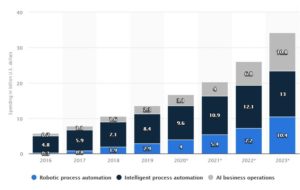Nowadays, the rapid development of technology has made automation the new norm. Thanks to AI-powered algorithms and machine learning (ML) technologies, many digital companies have been able to automate several aspects of their business: cybersecurity, document processing, app testing, cloud computing, and so on.
As the graph below shows, global spending on robotic process automation (RPA) and AI technology went from 5.8 billion dollars in 2016 to a whopping 16.7 billion dollars in 2019, tripling investment in RPA in less than 3 years.

Many digital companies invest in AI-powered processes to reduce costs and boost productivity. However, the many advantages of RPA are not only accessible to huge mega-corporations with gigantic budgets. Companies like Apple have started to make these tools accessible to more modest digital businesses too. Apple’s small business program, for example, is actively empowering companies by making RPA tools more accessible for small developers.
Initiatives like this are giving DevOps teams a bright future to look forward to. Imagine being able to create your own SaaS empire out of building software-based companies that run themselves through AI-powered automation. With the tools and insights given to you by webhooks, this is a genuine possibility.
Automation has made the development process simpler and more effective. With Filestack Workflows, you can use automation to do nearly anything – even choosing a lunchtime meal!
Cloud computing & IaC
Although it may sound similar to IaaS (infrastructure as a service), IaC (infrastructure as code) has pretty much nothing to do with what we usually associate with IaaS as a business model.
IaaS is a business model based on a computing infrastructure that is managed remotely via the internet. IaC, however, is the process of managing data centers through automated machine-readable files, instead of manual processes carried out with physical hardware.
IaC is a great practice for DevOps, thanks to its many advantages. These include:
- Speed and efficiency. IaC as a practice helps teams to quickly set up their development infrastructure by running scripts.
- Consistency. Thanks to the automation that comes with IaC, developers can easily get rid of the inconsistency and mistakes that come with the human factor.
- Simplification: Lastly, it’s important to note that IaC allows developer teams to manage their IT infrastructure using configuration files, making the entire process easier and more productive.
The best way to implement an IaC approach is by adding cloud computing to the mix to make the manual configuration of the DevOps process redundant. This reduces the costs associated with having an active workforce monitoring and running the process.
Automated testing
Testing is essential to achieve the best version of any project. Right now, I’m writing this article to help you implement automation, but this text will go through many changes. I’ll create various drafts before it can be published. The same concept applies to software development.
Thanks to the power of automation, the entire testing process has sped up how quickly a product is ready for launch. Developers can build a streamlined mobile DevOps strategy. Running automated tests allows developers to adjust apps according to user preferences, creating a user-friendly interface that satisfies their needs.
However, manual testing is important, and automated testing does not replace the human factor entirely. The DevOps process will always require some human input to understand the users’ point of view. However, automating more tedious tasks can save time and help you manage resources better, allowing developers to focus on fixing issues instead of spending hours looking for them.
Collaboration + automation = success
Having a roadmap that organizes your development process is as important as the testing itself. With the right schedule, you can keep everybody in the loop, set weekly calls, and implement project management apps for business teams. Collaboration in dev teams is crucial to their overall success.
If you decide to give this collaborative environment a test run, consider investing in software-based VoIP solutions. These cloud-hosted phones use multi-tenant cloud computing architectures that nurture a collaborative environment, allowing users to share resources in a public or private cloud.
Now, allow me to be very clear about this: I’m not saying you need to invest in setting up your own call center with a call forwarding service, predictive dialers, and call recording features. Nor do you need rigid calling schedules to manage your DevOps team. However, having some VoIP solutions to better communicate between departments is necessary, especially in the world of remote work environments.
What is the best collaboration team app for you? The market is full of options. Trello, for example, organizes ‘to-do’ lists to keep your teams on track and on top of projects. Apps like Wrike or Monday.com can set automated reminders that help developers meet deadlines or send automated messages to co-workers and team members that may be slowing down the process.
These apps help DevOps teams keep a history of their team’s progress during the development process. These features are useful if you want to see your developers’ output and have a look at how your staff have followed the deadlines set in your roadmap. Managers and project supervisors can keep eye on their workers without interrupting them for constant updates; they essentially work the same way call logs do, keeping an organized registry of call data in call centers.
DevOps security
Due to the compulsory shift towards remote working during the COVID-19 pandemic, many developers have been forced to stay home. As a result, remote working in DevOps has brought a series of unique cybersecurity challenges for companies, especially in the case of businesses enforcing BYOD (bring your own device) policies.
Digital businesses that employ BYOD practices are vulnerable to cyberattacks since staff members use their computers and laptops as business tools. If a developer’s personal device were to be attacked by a ransomware or spyware virus, that breach could directly affect the company.
The best solution to mitigate risks is implementing RPA cybersecurity tools. These cloud-operated automated tools search for possible threats and security breaches on their own and without supervision, sending automated alerts if necessary. Additionally, they can set password changes every few weeks to strengthen your safety protocols.
Automation as a goal
It’s important to note that automation shouldn’t only be viewed as a tool for your DevOps team but should be considered a key feature during the developing process.
What does that mean exactly? Well, if you have a quick look at the more popular apps and websites nowadays, you will spot a pattern: many use automation to improve the user experience. Let’s use a basic example – eCommerce apps.
Many online shopping websites and smartphone apps use automation to improve their UX and design, adding things like automated price tag calculators that apply discounts and calculate shipment and landed cost differentials for purchases. Other automated eCommerce services include things like inventory management or automated drop shipping.
The takeaway
As you can see, AI-based automation can be implemented across multiple facets of the development process. Giving your DevOps team the ability to leverage the power of RPA makes your workforce more efficient and boosts productivity along the way.
Now, before you go out there and start automating every aspect of your development process, let’s take a minute to do a brief rundown of what we’ve learned so far:
- Automation is already a huge part of the DevOps industry.
- Embracing IaC (infrastructure as code) will help bring automation into your development process.
- The testing process will be faster, cheaper, and more efficient if you decide to go with RPA.
- Automation can improve the collaborative part of the development process, connecting your teams and departments.
- Cybersecurity is extremely important (and automation can help you keep everything safe and secure).
- Automation is more than an approach to DevOps or a simple set of tools; it should be the goal and part of your final design.
Follow these simple tips if you want to make the most out of RPA, and you’ll be able to substantially improve your development process. Your competitors may already be doing it, so don’t get left behind!
Sunny is the Senior Director, EMEA Product Marketing & GTM for RingCentral. He has extensive Marketing experience across SaaS, Telecommunications, and Technology sectors within companies such as Vodafone, Reed Elsevier, Calor Gas, and SapientNitro. Sunny has also written for websites such as Hubspot.
Filestack is a dynamic team dedicated to revolutionizing file uploads and management for web and mobile applications. Our user-friendly API seamlessly integrates with major cloud services, offering developers a reliable and efficient file handling experience.
Read More →
